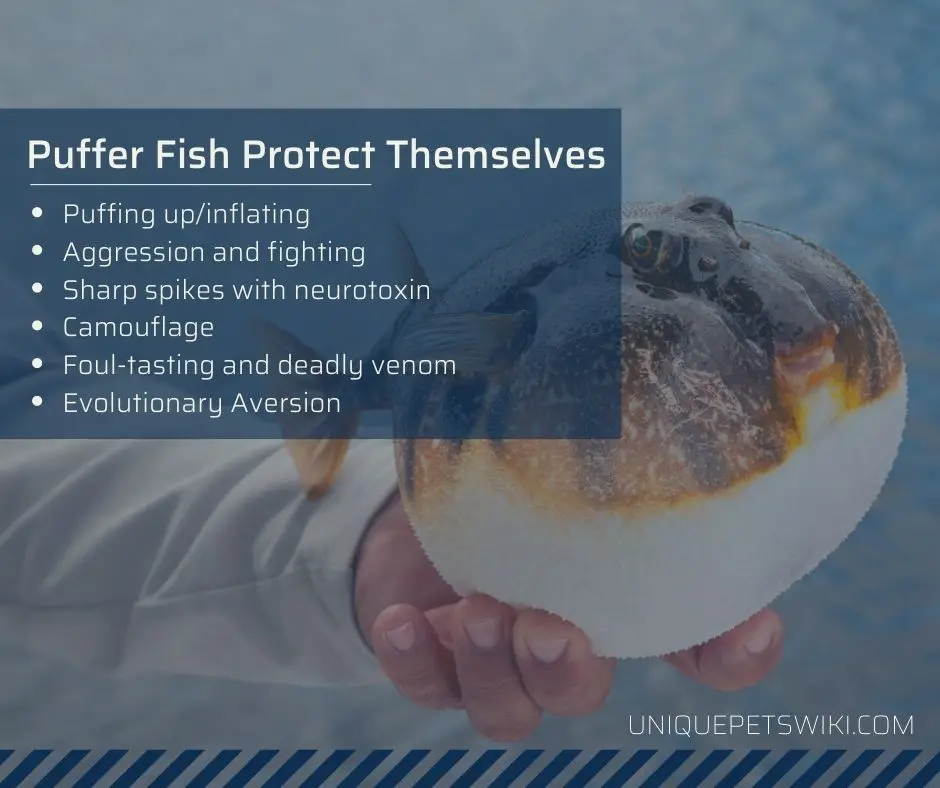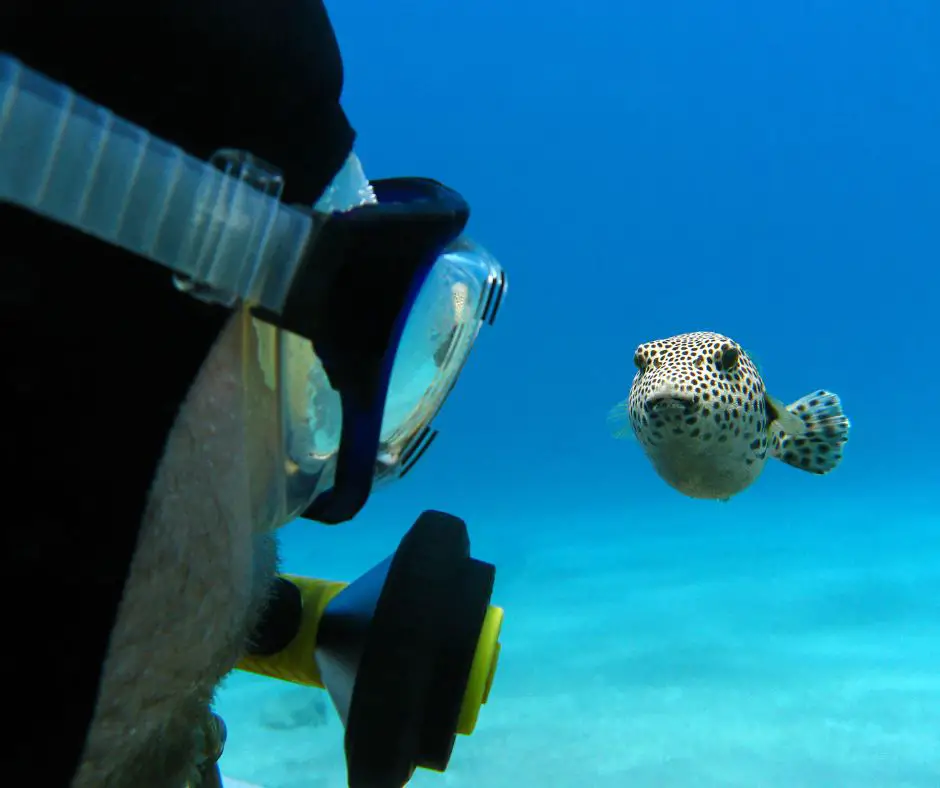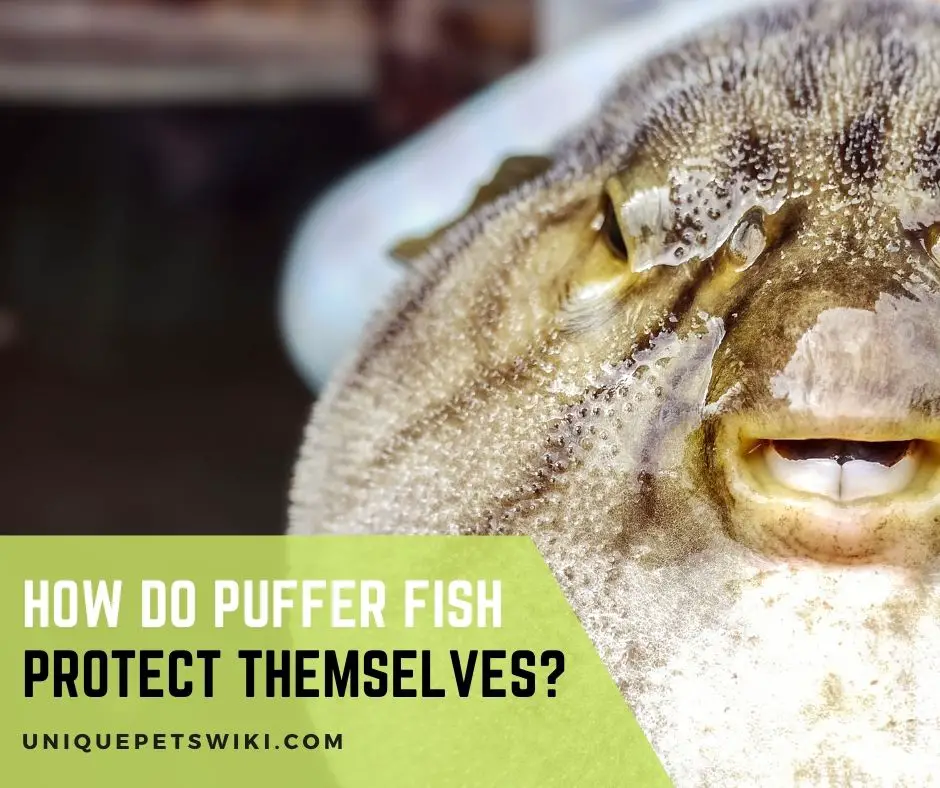In this guide, we will answer the question ‘how do puffer fish protect themselves?’
For any animal, one of the main challenges is to protect itself from its predators, so it can live long enough to reproduce and continue its species.
Puffer fish mainly defend or protect themselves by inflating or puffing up. Since there are different varieties of pufferfish, they may use different tactics or defense mechanisms for survival.
In this guide, we will talk about 6 different mechanisms used by different puffer fish varieties to protect themselves.
Contents
How Do Puffer Fish Protect Themselves?
Puffer fish mainly protect themselves by looking as unappetizing as possible to the enemy. Mostly, they puff up by swallowing a huge quantity of water or air.
They may even make use of their spikes to prevent the enemy from coming close. Almost all varieties of Puffers use a deadly toxin to harm their enemy.
Let us study each of these defense mechanisms in detail.

Puffing up/inflating
This is the primary method of self-defense in puffers.
They are equipped with an elastic stomach that can hold a large quantity of water which helps them blow up or inflate to almost three times their normal size.
The puffing action is quick and usually occurs within seconds. The swollen and puffed-up fish not only looks unappetizing to its enemy, but it also becomes difficult to swallow for the smaller enemy fish.
The action of puffing up or inflating is stressful to the Puffer since it puts a lot of pressure on its organs, muscles, and skin. If a captive pufferfish inflates in its tank, you may want to analyze the cause.
Keep an eye out on your Puffer’s tank mates to ensure there is no bullying going on.
You may also want to test the water parameters. If needed, make water changes and do ensure your puffer deflates after a few hours.
A puffed-up puffer fish looks like a balloon and young children often feel tempted to ‘pop’ it. Please warn them against doing so, since the action could harm the Pufferfish and may even kill it.
Aggression and fighting
Not all puffers use defense to protect themselves from predators and certain species of puffers are known to use offense or aggression to throw out other fish from their territories.
Some even use their sharp, hooked beaks for fighting other fish.
Sharp spikes with neurotoxin
Some puffer varieties have porcupine-like spines coated with toxins that they use to ward off predators.
The spikes are not only threatening to the predator but are also visually unappealing. Spikes also make it difficult for the enemy to swallow the pufferfish.
The pufferfish’s poison also shows up on their skin and these spikes, which help them fend off any predators that touch them.
Mostly, the spikes are present on the Pufferfish’s back and belly. They appear right during the larval stage so the pufferfish can protect itself right from its babyhood!
Camouflage
Puffers are available in various colors and they use this coloration to camouflage themselves.
Their colors often match the habitat around them helping them hide from their predators. (Pufferfish also use camouflage to prey upon other smaller fish).
Puffers with grey, brown, black, or dark blue colors blend with the ocean’s water. Their silver bellies and undersides also reflect light helping them hide from their enemies in plain sight.
Foul-tasting and deadly venom
Puffer fish usually use their venom to immobilize their predators. The venom is known as tetrodotoxin and it is very powerful and known to paralyze and kill the enemy within hours.
(If a human were to consume tetrodotoxin, they could be killed in under 6 hours.)
Moreover, the venom also renders the puffers foul-tasting and unpalatable to the enemy fish which is why they prefer to stay away.
The slimy coating on the puffer fish’s skin also makes them immune to parasites and harmful microbes from sticking to it.
Evolutionary Aversion
Sometimes, a puffer fish is not able to inflate and may be consumed by its enemies. In such a case, the puffer fish could still release its deadly neurotoxin tetrodotoxin which can kill the predator within hours after it has consumed it.
Humans, however, have learned how to clean the pufferfish properly to remove its venomous parts. In Japan, fugu (the Japanese name for Puffers) is a delicacy.
Special fugu chefs undergo hundreds of hours of training to learn how to remove the toxic parts of the Puffer – mainly the ovaries and liver that contain the tetrodotoxin. Therefore, pufferfish poisoning is quite rare in humans.
However, other predators are not so lucky. Many fish are known to die within a few hours of consuming the Puffer thanks to its deadly toxin.
This has induced an ‘evolutionary aversion’ in most of the Puffer’s natural enemies who now prefer to stay away from this species for obvious reasons.
What Are the Puffer Fish’s Predators?
There are over 120 different species of pufferfish that may be found in tropical and subtropical waters.
The pufferfish does not have too many predators other than certain varieties of sea snakes, lizardfish, tiger sharks, and humans.
A majority of the natural predators of puffers have learned to stay away from this deadly fish species as they are aware of the presence of toxins on their spikes and other organs.
It is worth noting that certain varieties of pufferfish such as Northern Puffers are not deadly poisonous like its tropical counterparts and they have several predators.
Also, some varieties, even though they contain the toxin, may not harm predators like snakes and sharks in the same way as they might harm humans.

Sea Snakes
In tropical warm waters, sea snakes are the main natural predators of pufferfish. They may have developed immunity against tetrodotoxin and can eat Puffers without getting killed.
Pufferfish are slow swimmers and often unable to outswim sea snakes so they end up becoming their prey.
Tiger sharks
Tiger sharks are known to feast on puffers. According to Pufferfish by Tori Miller, the Tiger shark may have developed a natural immunity to the Puffer’s deadly venom.
As mentioned above, puffers are not fast swimmers and are unable to outswim the Tiger shark. Moreover, they may not inflate themselves in time and end up being swallowed by tiger sharks.
Humans
Humans are the deadliest predators of pufferfish. As mentioned earlier, the Pufferfish is considered a seafood delicacy, especially in Japan.
Here, the fugu is revered as a ‘fortune’ and the word fugu is Japanese for ‘fortune’.
A full fugu meal in Japan is known to cost almost $200 but people are willing to pay this amount for the thrilling experience of eating one of the deadliest dishes on the planet.
It is estimated that the Japanese eat almost 10,000 tons of fugu each year! Some Japanese fish farmers have even started to farm non-toxic variants of fugu fish (Takifugu rubripes) by controlling their diet.
Conclusion – How Do Puffer Fish Protect Themselves?
Pufferfish inflate or puff up to protect and defend themselves from their enemies. Some Puffers use spikes with venom to scare away the other fish.
As such, Puffers don’t have too many enemies other than sea snakes, sharks, and humans.
We hope this guide helps you get a greater understanding of this marvelous and unique fish.
